A short story in pictures.







One day all your resistance is absent, and you want to write again.

So you start with what the resistance to writing might be about, and you find a lot of pictures of your house in the chaotic and interesting process of having its weatherworn decks rebuilt. I did not anticipate this level of mess and disruption, and beyond that: the delays wrought by the current supply chain disruptions. Few could have, but still. Here we are: disrupted.


We have the best and most artistic contractor in the world, and what they have been able to accomplish is stunning. California Bay Area building code is stunning in its requirements in a whole other way (can you say hiway woberry, overkill, way overkill, pirate nepotism, CYA and institutionalized bureaucratic job security in one long choking overdrawn breath?)
I prefer not to.

Of course that’s not all. I’m readying some new kits based on semi-popular demand at MMS+S. Above is the institutional mid-century modern-inspired set of file folders and papers meant to fill every beleaguered bureaucrat’s or scientist’s desktop. *Cigarettes not encouraged.*

I’m trying to keep my investment in forever plantings in tune with the remodel, but that’s basically been thrown right out the window. I could not resist this baby fig tree “Celeste” variety for the southwest corner of the top terrace.
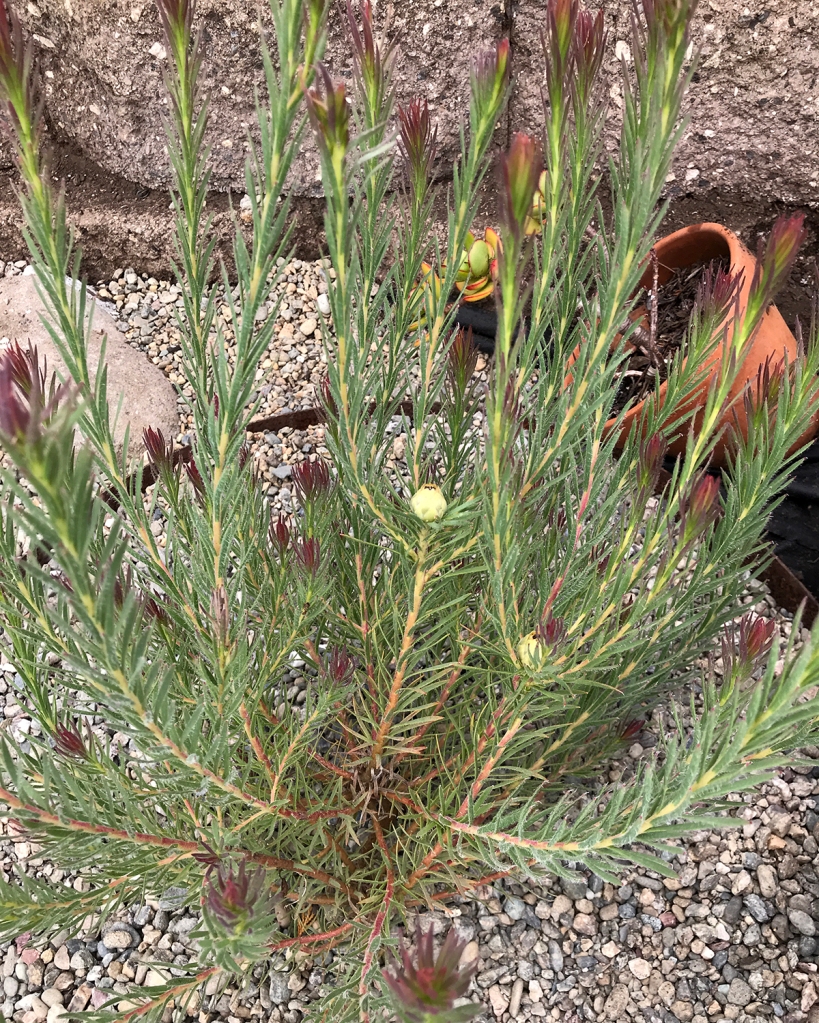
Likewise a few of these baby Leucadendron “Jubilee Crown” — a dream come true! — for the first and second tiers. Tag says they grow to six feet… UCSC Arboretum says otherwise, but let the best plant in the most beloved garden grow to what it will. I have kelp, and worm compost tea to help you be your best selves in quirky, foggy Pacifica.

This is a bull kelp washed up on the beach. They are a rich source of nutrients for all kinds of ecosystems, and I take only a small part home for my garden alchemy.

I’ll end where I started, with an image of Scarlett, this one of her distracting my attention, trying to make me laugh, making the Sea House Sea Rise Pavilion her own — and succeeding. In these times, I’m grateful.

The Sea House Conservatory deck needed a railing.

So I built one.


The Conservatory has a celestial motif in the leaded windows, which is carried through in the railing panel design.

I cut multiples of each panel from chipboard on the Cricut Maker. (Side note: I get the best results from editing the cutting presets, after a test cut on my chosen material.) I decided on a double, rather than triple layer, to lessen the alignment errors.
I used a lamination technique I learned from the talented Heather Tracy at Thicketworks. She uses thin cyanoacrylate on her intricate chipboard pattern pieces to seal, strengthen and stabilize the material. When dry they are easily sanded and very, very hard, and take acrylic paints beautifully.

To learn the nuances of the technique, I used one of Heather’s patterns she generously makes available free of charge. (She also has an Etsy shop, a YouTube channel of tutorials, and a maker club.) I made the blue wheelbarrow first, and then the red, slightly improving my results. It is a worthwhile technique, but messy. (Also, to me cyanoacrylate is one of those devil’s bargain products.) If you’re not familiar with Heather’s work, I encourage you to check it out!

After sanding the panels smooth — paying particular attention to the outside edges — I glued (using wood glue) them into post and rail surrounds.
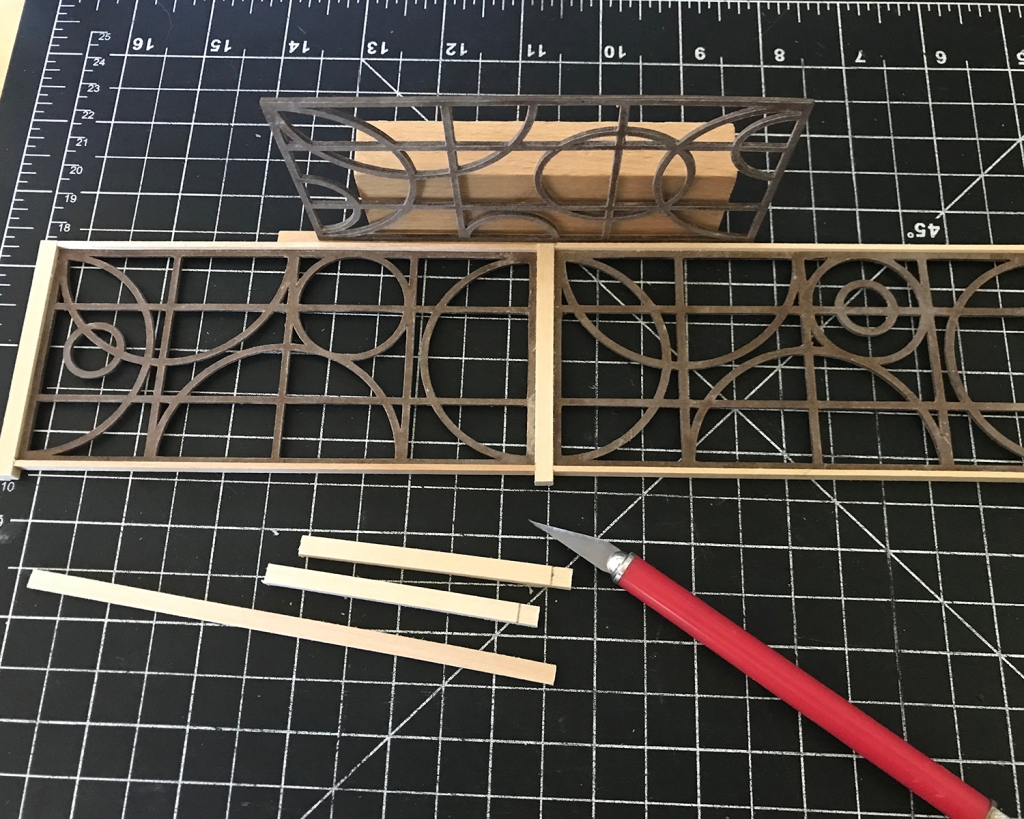
These were then joined into the L-shaped railing.
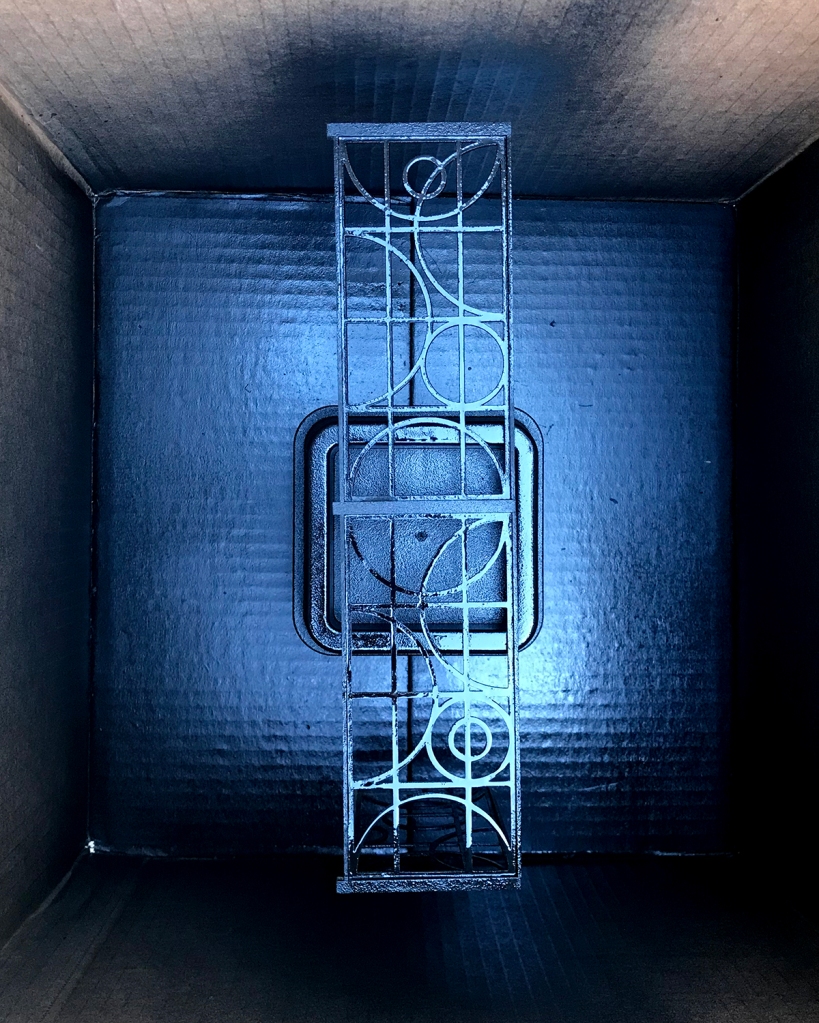
I sprayed the assembly with multiple light coats of matte black primer + paint, to seal and increase attachment bonds. After the glue and paint cures overnight, I’ll finish sand it and paint a final coat, then give it a matte seal.

I like a good wide top railing, for cats to lounge, elbows to lean, and drinks to be set upon, so I used 3/4- by 1/8-inch basswood. Thinking now of bracket designs to be cut from card stock to attach the railing securely to the deck, but that’s for tomorrow.

Having just finished watching the Amazon series Tales From The Loop, I’ll leave you with this image of Point Montara Light.

Late one night I decided to dry fit the HBS contest base because I needed to look at something new. I like the kit, but am undecided if I can responsibly build it. Ideas abound, and it’s currently on a turntable next to the studio thinking couch. It also makes a grand morning coffee cup platform.
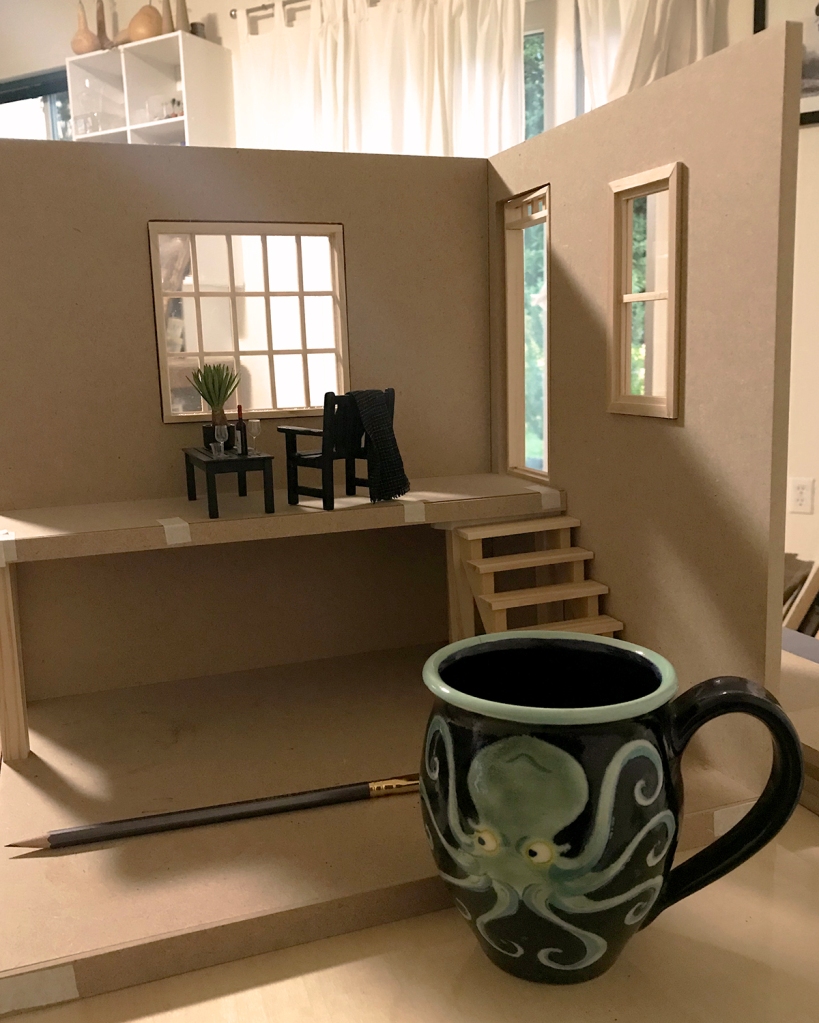

Here’s a glimpse of the under-pier, under-stair Sea House Conservatory setting. Barnacles by Keli, air-dry clay boulders, and flotsam from the natural and manufactured worlds.

When I saw just how much of the low tide water is in the shadow of the Conservatory structure, I thought some bioluminescence might add charm. This is four flickering LEDs set in the back corner, under the pier.

The effect is subtle, but smile-worthy, especially in the dark.
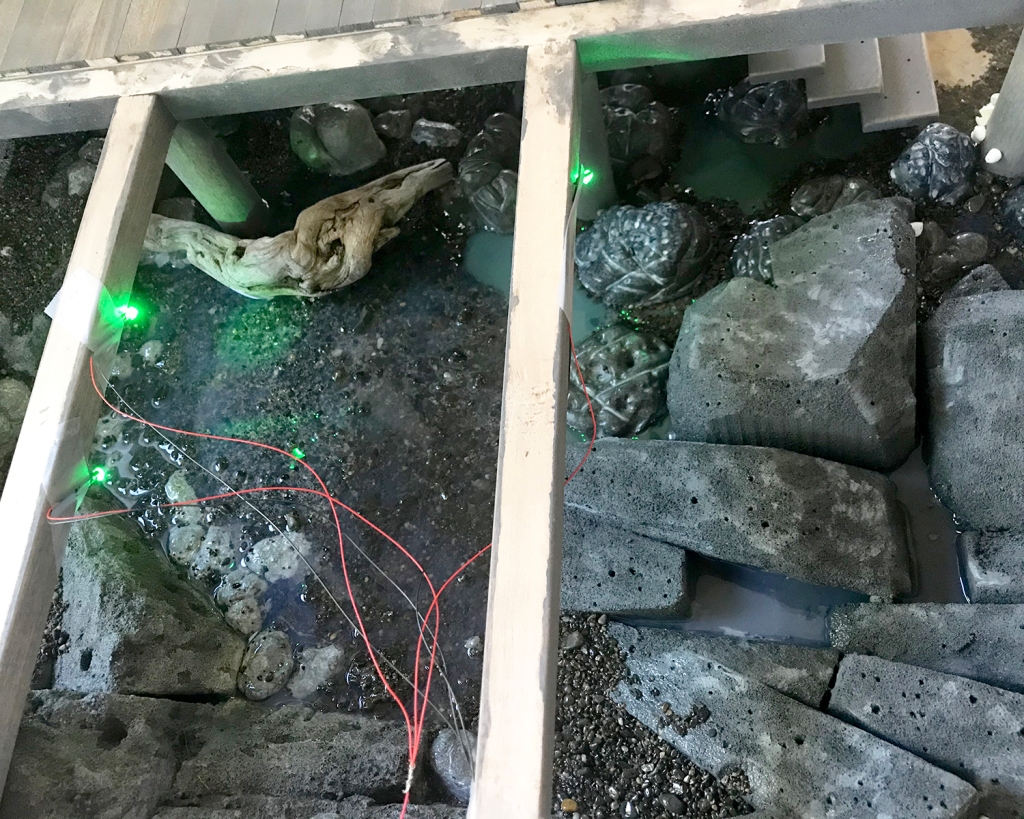
Here’s a shot of preliminary bulb placement. You can see some of just how much is unseen.

A night view of the mystery.
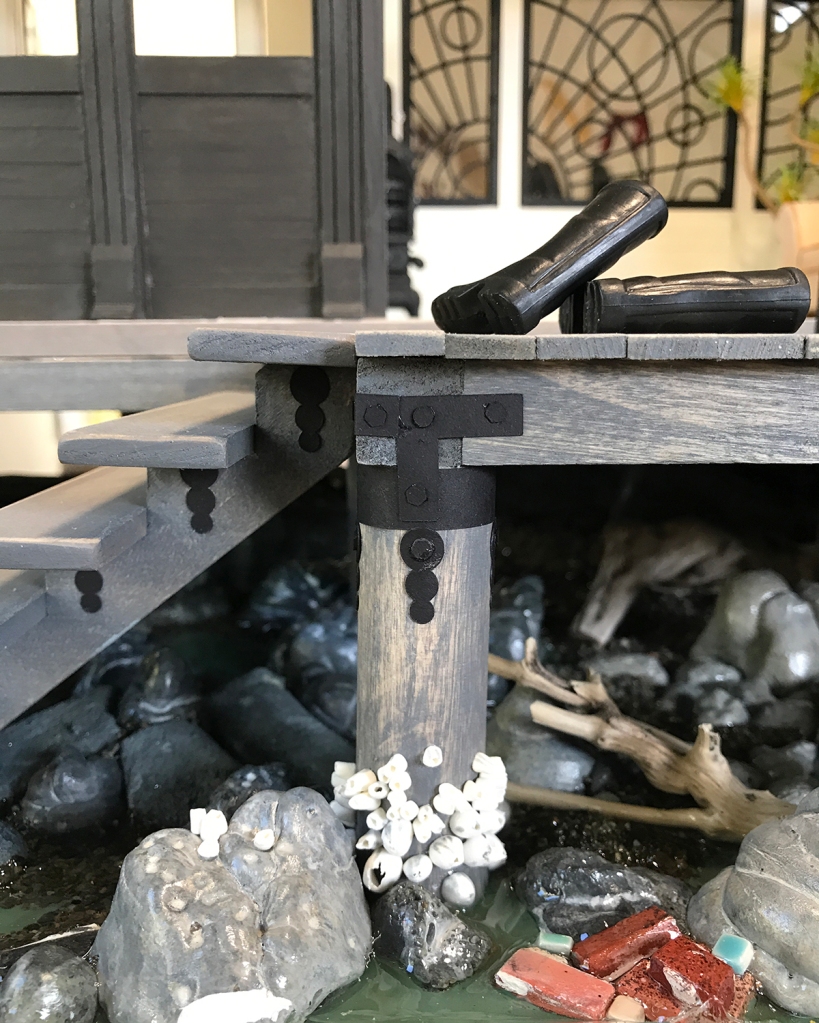
I indulged the rare decorative impulse to design pier piling hardware that echoes the Conservatory finials.

Oh wait, another what-lies-beneath shot.

This was one of my birthday views, taken from Point Montara Lighthouse in early March, on a day-long field trip with my Greater Farallones Naturalist class. There was a large pod of dolphins cavorting not far offshore, visible through the very many pairs of binoculars and spotting scopes.
The pandemic was already getting real, but that was the last time I sat by the ocean, side by side with my classmates, eating our bag lunches together in the intermittent sun and light rain.

Here’s an image from a series Keli and I have been punting about. It started when Keli found a scale model canoe builder in Maine who makes these beautiful 1:8 paddles. We each bought one and the challenge is on Instagram #littlepaddletales and #paddlehomage. It’s been fun.
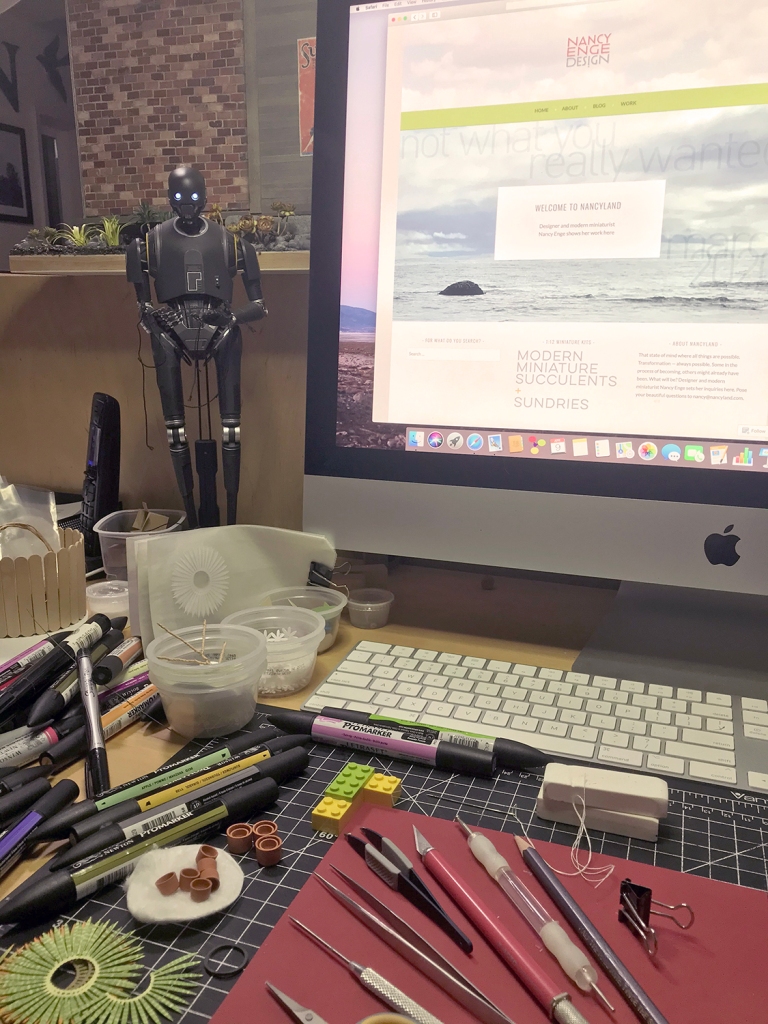
Mostly, my family and I are OK. My charming husband has been working from home — as I have been for the last 14 years — and given the wee square footage of our house, it’s been remarkably harmonious and kind. We’ve weathered the death of my younger brother, after a long illness, without being able to gather and grieve his passing, and most recently, the furloughs and layoffs of half of my husband’s corporate master company.
The awareness that many others are experiencing far worse experience and circumstance is never far from my heart and my mind. How could it be otherwise? We are all in this together. (And for all of you who have reason to say fuck you with two middle fingers to this trite truism, I hear you.)
However.

Ruby and Maddie are learning to wash dishes. Without me.

Scarlett maintains her unrepentant insistence on knowing interior spaces.


Um, nothing much new in that propensity.

My birthday was in early March, and I splurged on new deck furniture from Tidewater Workshop. Of course our planned new front deck construction is delayed until who knows when, but I built and painted all the new pieces with the leftovers from the wave gate project, and am sealing them as the weather allows. Above are three of the rectangular side tables.

The recent April full moon coincided with my mother’s birthday and mild weather. What a wonderful reason to sit outside late and watch the night sky.

I’ve been keeping busy with multiple projects and diversions. This 1:12 scale Bandai kit was so very satisfying to build.

What with shelter in place and all, my walks are constrained to our hilly mid-century suburban neighborhood, and I’m keen on … finding more interesting things to notice than whatever, or sweating, or not dying from a heart attack. (My neighborhood *is* really hilly.) So today it was flowers, and this one won: Cerinthe major ‘Purpurascens’ honeywort. I use the iNaturalist app to help me identify that with which I am unfamiliar.
If only there was one for our time.

Although this photo was taken during high tide, this is the water feature look I want to emulate on the Sea House Conservatory low tide build.

After watching countless hours of video demonstrations from a variety of sources, I started my experiment with a small area at the front of the Leadlights landscaping that seemed natural for a water incursion. I glued a 2-inch tall length of acetate to the project board to form a dam, several inches longer than the intended 4-inch-wide pour, reinforced with masking tape below and tape holdfasts above.

Several deep breaths and I poured a scant quarter-inch of Realistic Water ™ from Woodland Scenics into the prepared area. Recommendation is an eighth-inch, but hey, it pours fast. So far so good.

I did the same prep on the Conservatory project board.
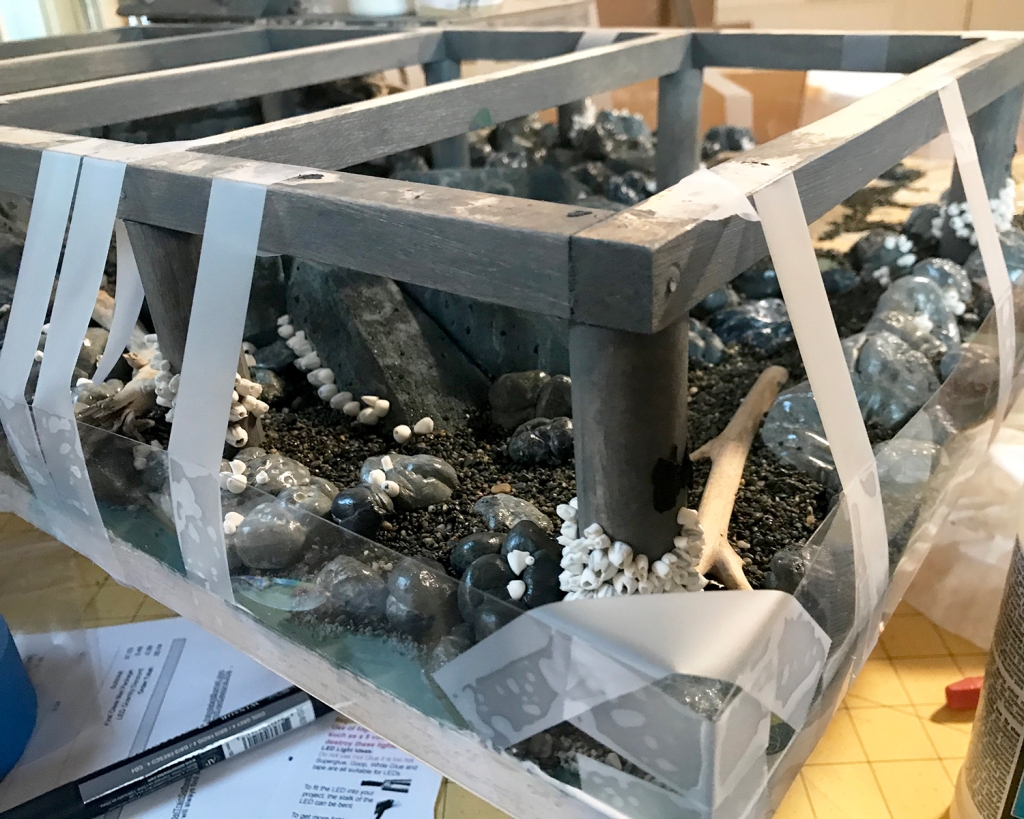
One tricky situation encountered is when any element of the landscaping extends past the base, even a little. I had some time to consider ways I will do it differently next time, as I held the acetate to the base while the glue set adequately.
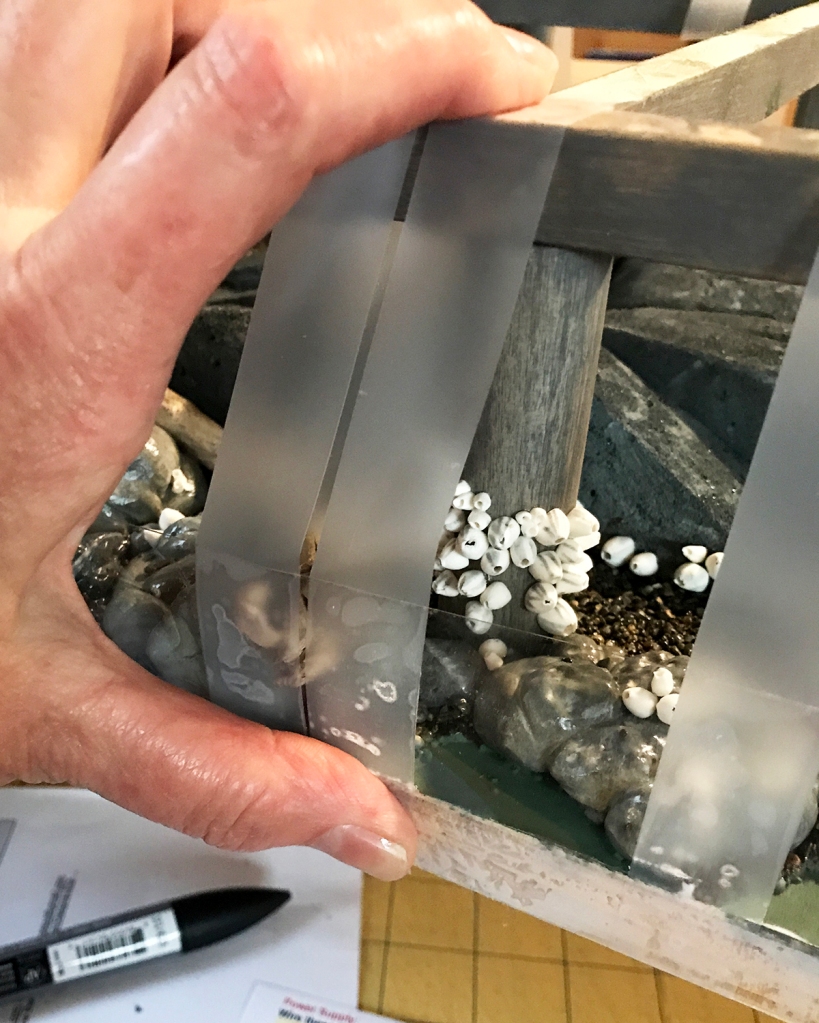
When the glue seemed set, I boldly — yet delicately — poured the first course of water into the prepared base. Altogether, five or six individual glugs into each tide pool and basin.

Unsurprisingly, as I looked and marveled at the swampy effect and the no-going-back-nowness, a few small, very slow leaks began to develop. I used wide painter’s tape to further seal — more on that later — the acetate dam to the base. Checking again about two hours later I added more tape, and also noticed a few small areas where the glue I had used to cement the gravel and boulders to the base seemed to be turning opaque white.
Hmmm.
The recommendation for the water product is to let each layer dry at least 24 hours. It was very late by this time, so I called it a night very early morning and went to bed.

Next morning, not 24 hours later, I was encouraged to see the water was turning clearer, but the small white areas were still present, noticeably in the transition areas of gravel I had applied a few days earlier.

So I re-read the product label instructions.

Not for use with PVA glue. I’ll shorten my whole lengthy tirade — who doesn’t commonly use PVA glue? Why wasn’t this the very first caveat on the label, and why was this condition never mentioned in any of the company’s instructional videos on use of the product, etc… and lots of swears and unkind, rude assumptions and declarations. But then there was the offhand “Cure above 70°F.” Thankfully I have a wise and patient bitch buddy to vent to with whom I can vent. You know who you are are.
Then I calmed down enough to embrace that since there was nothing I could do about it now, I’d wait and see what would continue to happen. After all, it had not been even 24 hours yet, and it is a rather larger area and blah, grumble, blah.
I wasted more time did more research on pouring water, this time with a variety of mediums and preparation techniques, and even grubbed around in some forums, which I detest, and learned that yes/no there are some/not any problems with PVA glue that can be gotten around by sealing everything with — and here again suggestions vary — some sort of varnish, and, most valuably, some clever ways to build and seal dams for water feature success. One involved swamp water.
Time passed, and my watery problems with this product mostly resolved themselves. I continue to steep myself in the experiences of others.

I did a second pour on Leadlights, and a second and third pour on areas of the Conservatory. Above you can see the dam removed to reveal the fully cured water. (One of the plants bled a little color into the water, but I don’t mind.) I wanted a “live edge” to the water, and used an Xacto knife to carve away the lip. The project base itself will be edge-banded with thin basswood for a finished look :)
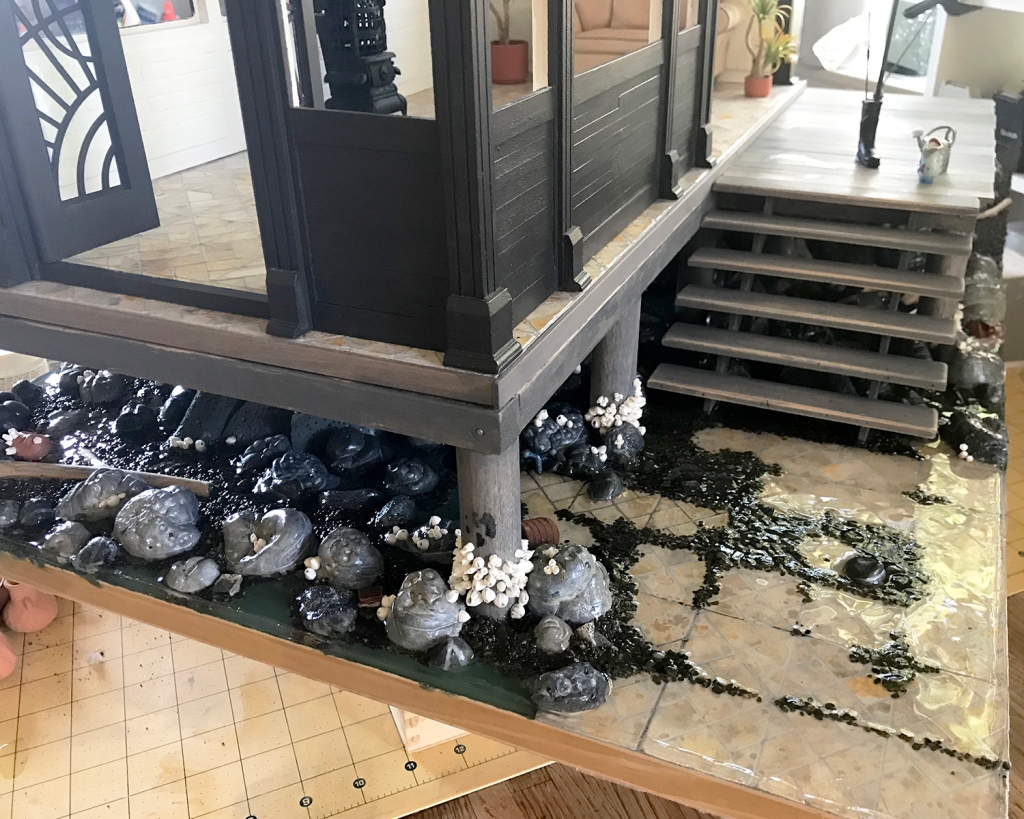
All in all, I am happy with and consider the results a success. I’ll know so much more on the next one.
Check out the light shimmer on the right pier piling, a reflection from the late afternoon light. Magical realism, which validates my efforts :)
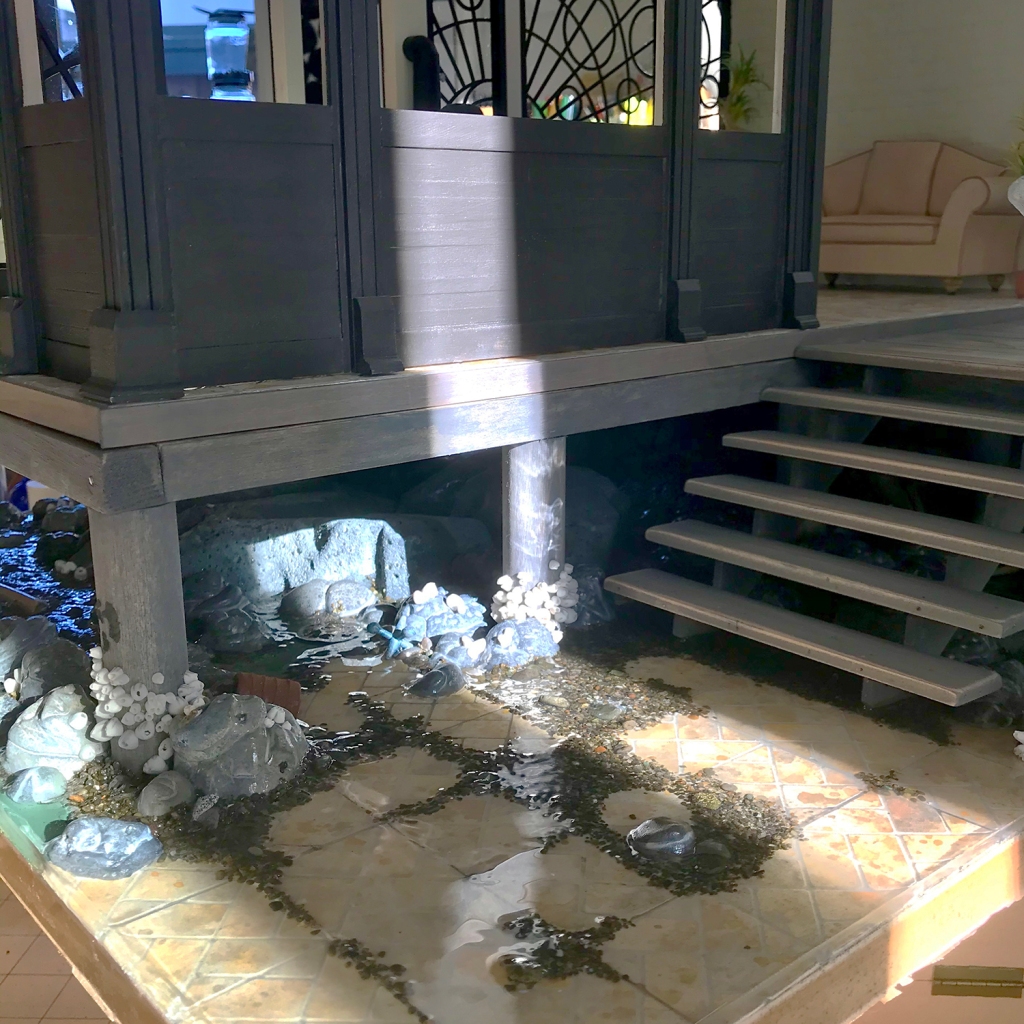
I’ll leave you with this image found in Bolinas, on the estuary marsh/riparian transition on a winter afternoon hike at low tide. (Very low and long ago for this guy.)


In preparation for creating the tidal water surge under the Sea House Conservatory, I mixed up a nice ocean green base color and painted it generously on the project board. I made sure the whole 26 x 20-inch base — foam cliff landslide, boulders, cobble, gravel, old tiled patio — was well-sealed with glue or paint to prevent water leaks. Two-inch tall heavy acetate strips were cut, ready to glue to the base to form a (removable) perimeter dam.
I estimated an area about 18 by 18 inches would be covered an inch deep, then used the Woodland Scenics water estimator to see how much product I needed to buy. Two, maybe three bottles?
Um, no. No, no, no. Depending on whether I chose “Realistic ($24 for 16 ounces)” or “Deep Pour ($30 for 12 ounces)” the estimated 180 ounces required 12 or 15 product bottles, costing a total of $288 or $450. For a feature, however awesome, mostly obscured beneath the Conservatory deck, this makes no sense. Back to the proverbial literal project board to drastically reduce surface area.

After fashioning more florist foam into reefs and rocks, I glued them to the project board.

Starting this time with black Model Magic, I forged another batch of accent rocks.


The foam shoreline formations were generously sealed and detailed with a few shades of warm and cool gray acrylic and stabbing holes with a pointy thing. All base edges were given a transitional application of gravel, cobble and accent rocks. These were allowed to dry, excess gravel brushed out, and the process repeated.

“What are those white cone things?” I can hear those of you looking at this photo on your phone exclaim. What, yes! Those white things are perfect barnacles, crafted by Keli of iseecerulean.com.

(I am not ungrateful. We have a longtime water-influenced exchange going on.)

I did a final brushing and shaking off loose gravel after the glue dried over my (1:1 life) front deck, just as the sun was setting.
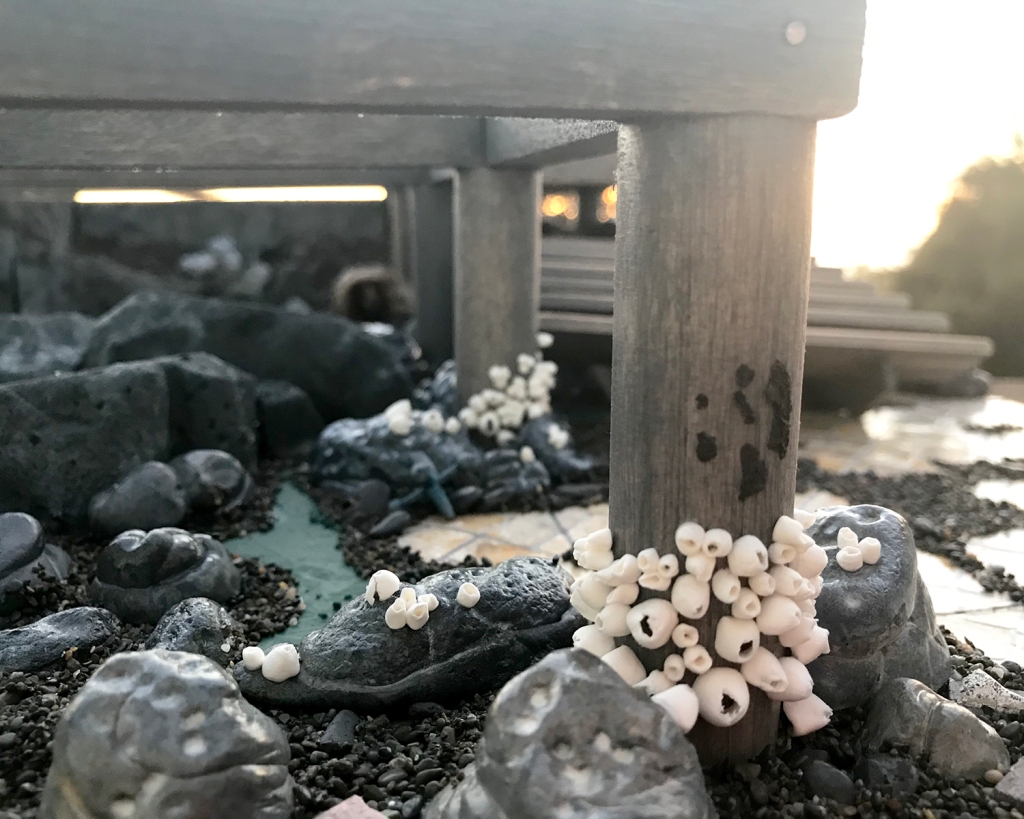

You know how it is when maybe you fall a little bit too much in love with your build? That’s how it is for me right now with these sunset light photos. I have about a dozen that made first, even second cut, and they are all epic. One more, please indulge me.

I sighted through all the open viewpoints, and as I mentioned earlier, most all will be obscured once the Conservatory is in place. But I know, and now you do too, what lies beneath.

I bought two of Kris Comapas’s Estate Chair kits because I wanted to use more of this thrift store dress fabric, which I love.


It’s a rather large scale print for miniature upholstery, as well as being a very fine and lightweight fabric, but did I mention how happy it makes me feel?

Kris includes good instructions and cord to make fabric-covered piping in her kits, but I generally prefer a twisted cord made from 3 strands of embroidery floss.

Here you can see my associate K-2SO inspecting the floss piping with his massively articulated fingers. (I love him, too.)
I find attaching tiny piping gracefully onto miniature upholstery to be a tedious task, so I’m putting it off until I feel more… um, articulated dextrous. And patient.

The Leadlights design studio also has a new chair. Makes it look way more office-y, don’t you think? I’m really pleased with the level of quality and detail in this chair. (Ack! This photo also reminds me I want to finish tricking out the desk accessories, and to trim that orange bookmark on the last-minute-made sketchbook!)

Work continues on the Sea House Conservatory build, with a sea level rise remediation support pier in place.

Geologic rock and boulder construction is underway. My preferred material — think I’ve tried just about all of them — is Model Magic air dry clay, made by Crayola. It is lightweight, inexpensive, readily available, pleasant and responsive to sculpt, accepts all kinds of pigments well, and dries with virtually no shrinking.



With this last batch of rocks, I experimented with adding black acrylic paint or India ink to the white clay before sculpting. One batch had fine black gravel mixed in. The paint or ink initially made the compound stickier to work with, but it was nice to start with a pre-tinted base. These have green and gray washes spritzed on. When dry (takes a day or two depending on size and relative humidity) with a fine brush I painted the surf erosion holes and granite veins with white acrylic, diluted 1:1 with water.
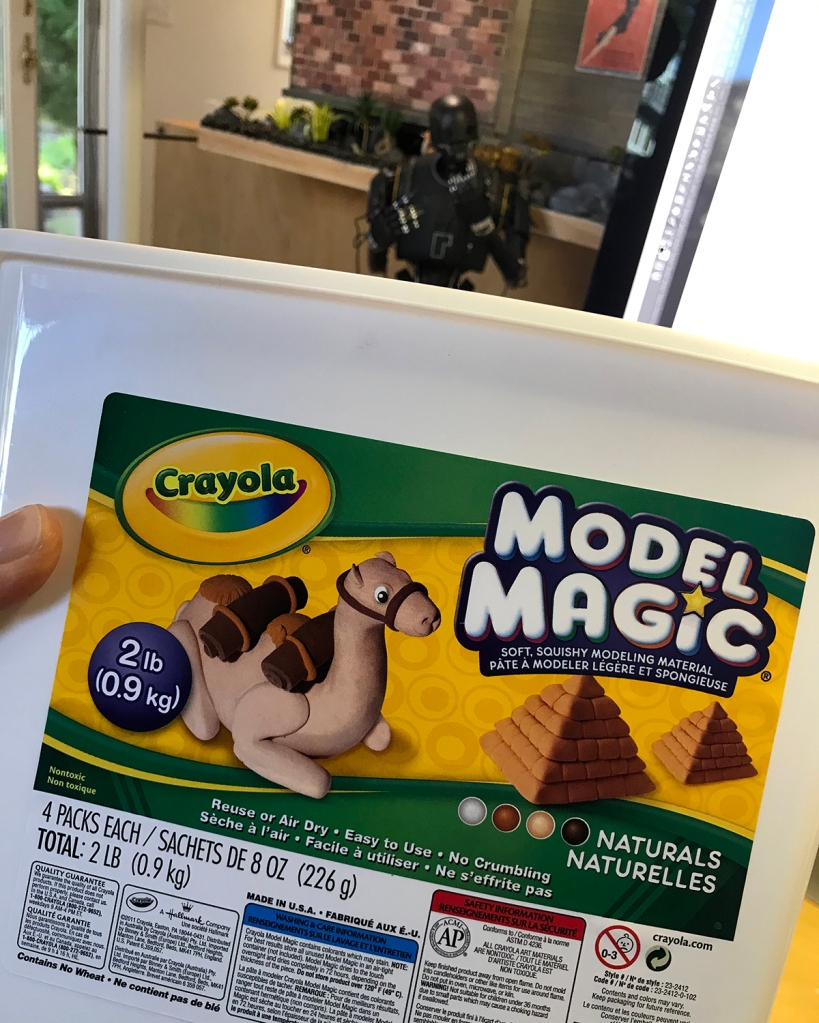
As I was ordering new clay, I learned Model Magic also comes in black, gray, and “Earthtone, Bisque and Terra Cotta”. So stoked to use these colors on the next exploratory rock and boulder sets.

The finished rocks are slicked with a satin multi-purpose sealer, as they’re meant to look wet. The final Conservatory project base will have about an inch of water in tidal flow. (I’m excited about that, too, as I’ve never worked with a “water feature” before :)

Deck planks are installed, and I’ve finally arrived at a stair design that makes sense and blends into the overall structure.
Yesterday I was at Chrissy Field in the Presidio, and took a bunch of pier photos for genuine detail ideas. It was a perfect winter’s day, cool, clear and sunny, with very little breeze.


Glorious.
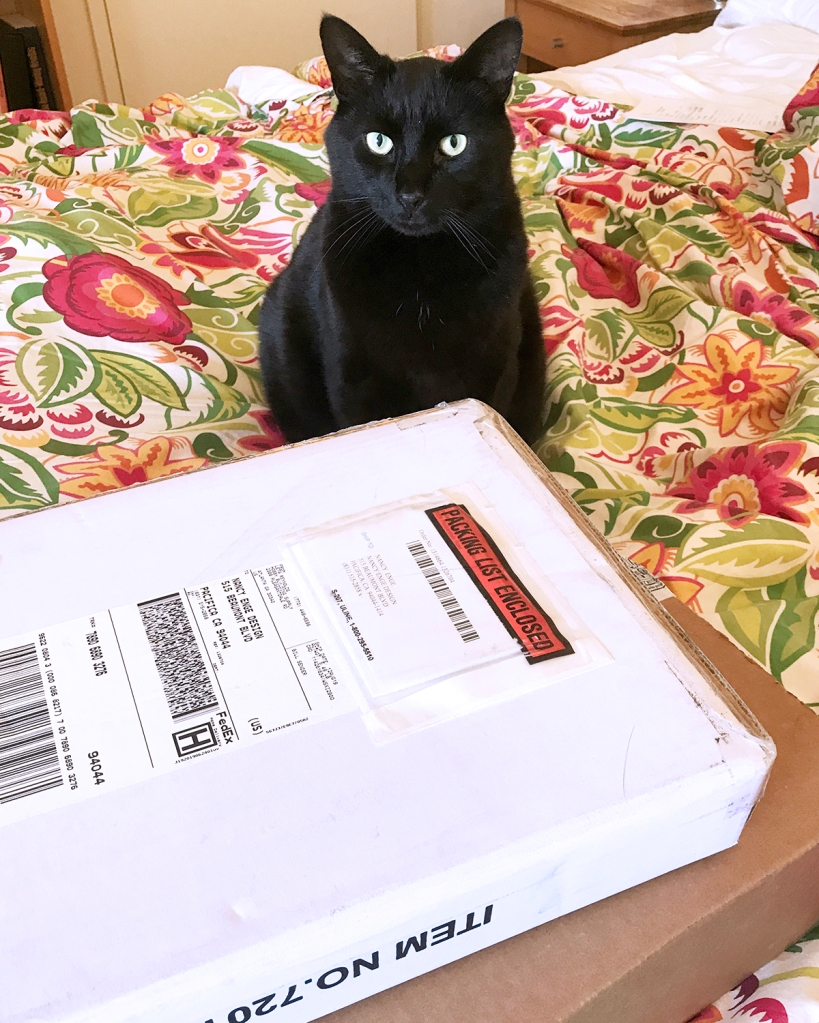
I thought it might be interesting to review building highlights of the Sea House Leadlights studio office, from start through submission. (Can’t really say “completion” because things never stay done ‘round here.) There are links back to original posts — if any were made — with more details. I wasn’t very bloggy :)

I spend a lot of pages thinking, sketching, dreaming, considering and working out dimensions and story.

The first floor idea, though fun to design, paint and assemble, did not work well in the space. So it goes.

Height was added to the starter kit with parts from a second. I like to retain recognizable elements of the kit, so the roof angle and footprint, as well as door and lower window placement remained unchanged.
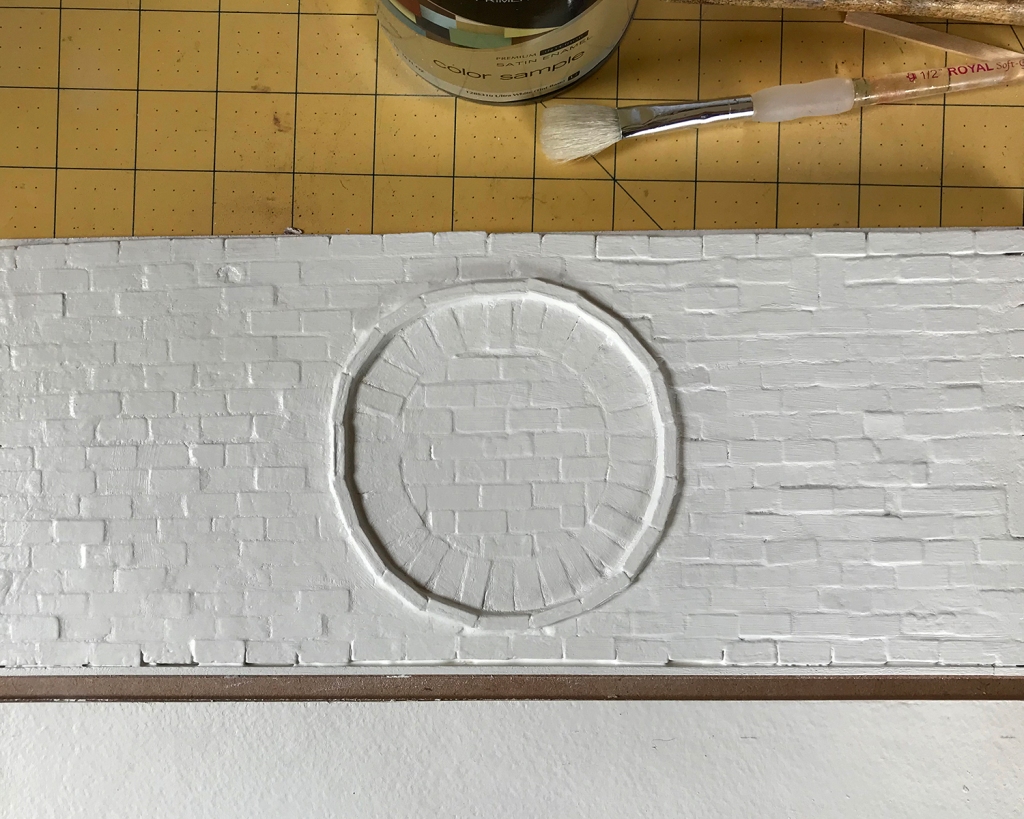
I glued cold press 140 lb. watercolor paper to the walls for texture before painting, and added a whitewashed aged brick back wall in the loft.


I opted to make the front façade removable as well as the roof… this makes it so much easier to photograph the interior.

I cut the built-in benches from 1/16-inch basswood on the Cricut Maker. These were glued together and supported with 1/8-inch dividers.
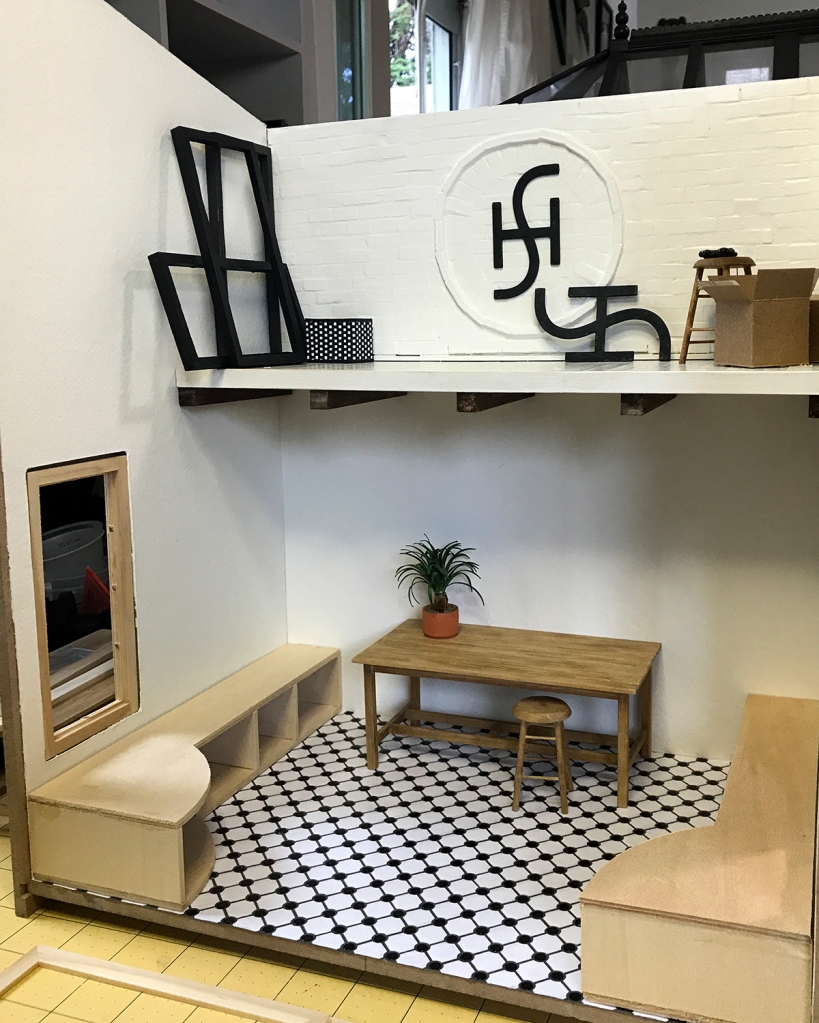

I thought and sketched about the window designs for some time. The Pavilion is bubble-themed; the Conservatory celestial… for the Leadlights design studio I went Egyptian Deco. Mostly sort of.
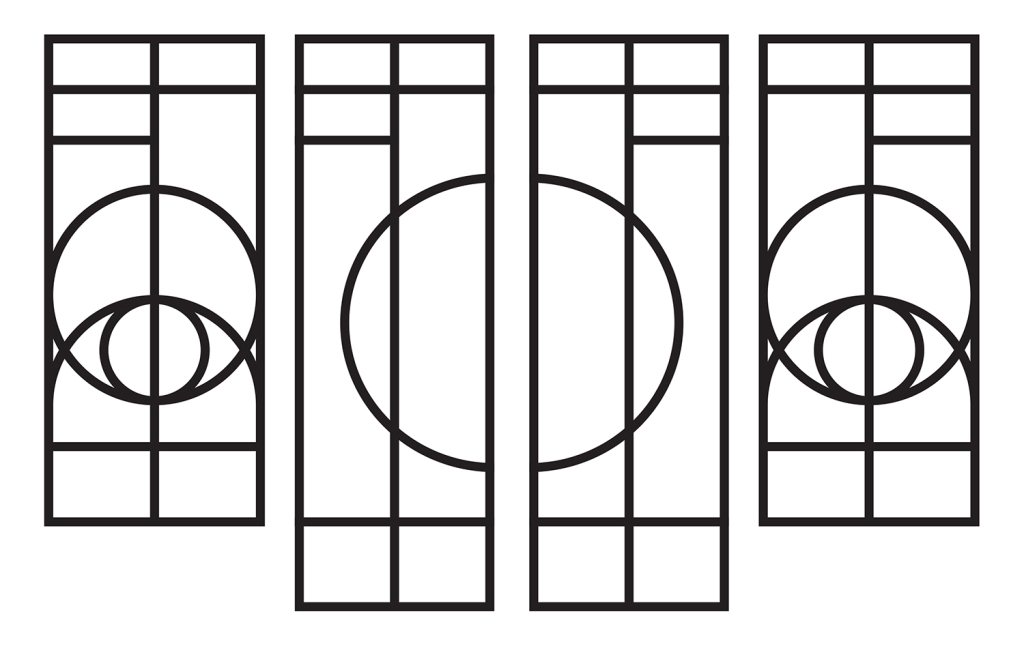

The upper window is a stylized scarab. Very.
The “leading” designs for the windows are cut from lead black cardstock, glued front and back to the plexi, then framed in black on the exterior (and tree frog on the interior). I like to see wood grain, so I use a 1:1 ratio of acrylic paint and staining medium.

If one looks straight on, the window frames the bricked loft wall and the old Sea House logo. With sacred scarab wings.

I — or rather the Cricut Maker — cut the signage from matte black vinyl. The stars in the design are meant to resemble anchor plates used to reinforce old buildings. I love them.
In this backlit photo, the vinyl letters appear to float off the side of the building. It’s not quite so unnatural-looking in person, but knocking back the synthetic smoothness is on my eternal learn-to-do list, to find ways to tone down the material. (Transferring wee letters and figures is a fiddly, fussy business, especially onto an uneven surface, and I am not eager.)


Here’s a roof’s-eye look at the progressing build. The holes are drilled for the LED light fixtures that will illuminate the work space below. (The wiring to be concealed beneath a custom rug and other stuff stored in the loft.) A narrow shelf beneath the scarab window on the removable front might support batteries if I ever add lighting to the front. Floor tiles gleam softly with scuff-resistant utility. Leather window seats beckon.
To be continued…

The entrance to the Sea House Leadlights office is up a few stairs and across the deck to the left of the fireplace. A set of leaded glass doors opens into a snug but functional design studio.
Details: Terra cotta pot by Braxton Payne. Basswood deck and siding stained with Minwax Classic Gray. Pumpkins made from tissue paper and thread. Boulders sculpted from air dry clay painted with acrylic washes and sealed with ultra matte varnish. All succulents, yucca and other plants hand colored with W&N Promarkers. Many are prototypes; some available as kits at Modern Miniature Succulents + Sundries.)

Beneath the half-loft a large tabletop desk has plenty of room to roll out plans and inspiration. Low built-in cabinets with black leather cushions provide more seating, storage and level surfaces for tea trays.
Details: The ceiling lights are 12V modified for warm white LEDs. Bulletin board is made from cork sheet framed with basswood stained to match. Sketchbooks made from my kits at MMS+S. Various meaningful artifacts including original leaded glass designs for other Sea House buildings, and a drawing of a cat by my then 4-year old daughter. Fèves, prized vintage Monopoly shoe, and an anodized earring from the 1980s.

The white-washed brick loft stores window frames, tools, Sea House memorabilia and miscellaneous treasure — as well as the switch (lift the black basket) and battery pack (hidden in a custom box) for the LED lights.
Details: Oh yeah, the baskets and boxes are also available as kits at MMS+S.

A gazebo-style roof welcomes natural light. (I’ll detail more of that happy construction in another post.) I made the 1:144 scale basswood model of the source kit for the original Sea House Pavilion, built some years ago. The Egyptian cat is a porcelain fève. Best of all is the vibrant painting by Jim Tracey that commands the studio — also another post.
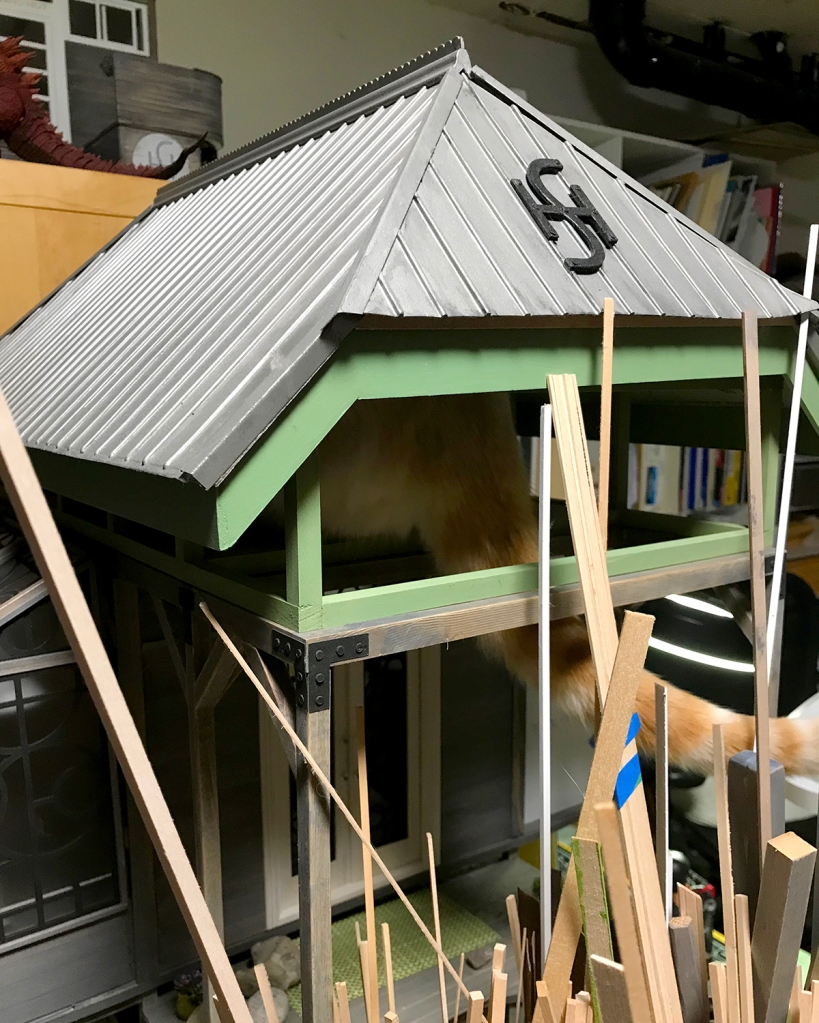
Finally, of course, Scarlett. Here she has somehow managed to fluidly infiltrate an impossibly small entrance to the Sea House Sea Rise Pavilion loft (my ongoing remodel of the original 2013 build.) I swear she does these things just to remind me she can.
Oh, how she makes me laugh.